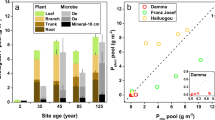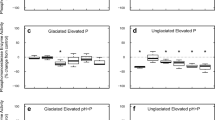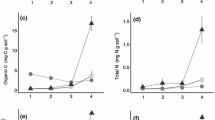Abstract
Background
Soil phosphorus availability declines during long-term ecosystem development on stable land surfaces due to a gradual loss of phosphorus in runoff and transformation of primary mineral phosphate into secondary minerals and organic compounds. These changes have been linked to a reduction in plant biomass as ecosystems age, but the implications for belowground organisms remain unknown.
Methods
We constructed a phosphorus budget for the well-studied 120,000 year temperate rainforest chronosequence at Franz Josef, New Zealand. The budget included the amounts of phosphorus in plant biomass, soil microbial biomass, and other soil pools.
Results
Soil microbes contained 68–78 % of the total biomass phosphorus (i.e. plant plus microbial) for the majority of the 120,000 year chronosequence. In contrast, plant phosphorus was a relatively small pool that occurred predominantly in wood. This points to the central role of the microbial biomass in determining phosphorus availability as ecosystems mature, yet also indicates the likelihood of strong competition between plants and saprotrophic microbes for soil phosphorus.
Conclusions
This novel perspective on terrestrial biogeochemistry challenges our understanding of phosphorus cycling by identifying soil microbes as the major biological phosphorus pool during long-term ecosystem development.


Similar content being viewed by others
References
Allison VJ, Condron LM, Peltzer DA, Richardson SJ, Turner BL (2007) Changes in enzyme activities and soil microbial community composition along carbon and nutrient gradients at the Franz Josef chronosequence, New Zealand. Soil Biol Biochem 39:1770–1781
Almond PC, Moar NT, Lian OB (2001) Reinterpretation of the glacial chronology of South Westland, New Zealand. N Z J Geol Geophys 44:1–15
Blackwell MSA, Brookes PC, de la Fuente-Martinez N, Gordon H, Murray PJ, Snars KE, Williams JK, Bol R, Haygarth PM (2010) Phosphorus solubilization and potential transfer to surface waters from the soil microbial biomass following drying–rewetting and freezing–thawing. Adv Agron 106:1–35
Blum JD, Klaue A, Nezat CA, Driscoll CT, Johnson CE, Siccama TG, Eagar C, Faheyk TJ, Likens GE (2002) Mycorrhizal weathering of apatite as an important calcium source in base-poor forest ecosystems. Nature 417:729–731
Brookes PC, Powlson DS, Jenkinson DS (1982) Measurement of microbial biomass phosphorus in soil. Soil Biol Biochem 14:319–329
Brookes PC, Landman A, Pruden G, Jenkinson DS (1985) Chloroform fumigation and the release of soil nitrogen: A rapid direct extraction method to measure microbial biomass nitrogen in soil. Soil Biol Biochem 17:837–842
Chapin FS III, Barsdate RJ, Barèl D (1978) Phosphorus cycling in Alaskan coastal tundra: a hypothesis for the regulation of nutrient cycling. Oikos 31:189–199
Chave J, Coomes D, Jansen S, Lewis SL, Swenson NG, Zanne AE (2009) Towards a worldwide wood economics spectrum. Ecol Lett 12:351–366
Cleveland CC, Liptzin D (2007) C:N:P stoichiometry in soil: is there a "Redfield ratio" for the microbial biomass? Biogeochemistry 85:235–252
Coops NC, White JD, Scott NA (2002) Assessment of regional forest and scrub productivity using a coupled vegetation process model with remote sensing. Geocarto Int 17:5–14
Cordell D, Drangert J-O, White S (2009) The story of phosphorus: global food security and food for thought. Global Environ Chang 19:292–305
Crews TE, Kitayama K, Fownes JH, Riley RH, Herbert DA, Mueller-Dombois D, Vitousek PM (1995) Changes in soil phosphorus fractions and ecosystem dynamics across a long chronosequence in Hawaii. Ecology 76:1407–1424
Fierer N, Schimel JP, Holden PA (2003) Variations in microbial community composition through two soil depth profiles. Soil Biol Biochem 35:167–176
Frossard E, Stewart JWB, St Arnaud RJ (1989) Distribution and mobility of phosphorus in grassland and forest soils of Saskatchewan. Can J Soil Sci 69:401–416
Halm BJ, Stewart JWB, Halstead RL (1972) The phosphorus cycle in native grassland ecosystems. In: Isotopes and radiation in soil-plant relationships, including forestry. International Atomic Energy Authority, Vienna, pp 571–586
Hedin LO, Vitousek PM, Matson PA (2003) Nutrient losses over four million years of tropical forest development. Ecology 84:2231–2255
Holdaway RJ, Richardson SJ, Dickie IA, Peltzer DA, Coomes DA (2011) Species- and community-level patterns in fine root traits along a 120 000-year soil chronosequence in temperate rain forest. J Ecol 99:954–963
Kouno K, Wu J, Brookes PC (2002) Turnover of biomass C and P in soil following incorporation of glucose or ryegrass. Soil Biol Biochem 34:617–622
Lagerström A, Esberg C, Wardle DA, Giesler R (2009) Soil phosphorus and microbial response to a long-term wildfire chronosequence in northern Sweden. Biogeochemistry 95:199–213
Lajtha K, Schlesinger WH (1988) The biogeochemistry of phosphorus cycling and phosphorus availability along a desert soil chronosequence. Ecology 69:24–39
Lambers H, Raven JA, Shaver GR, Smith SE (2008) Plant nutrient-acquisition strategies change with soil age. Trends Ecol Evol 23:95–103
Lambers H, Brundrett MC, Raven JA, Hopper SD (2010) Plant mineral nutrition in ancient landscapes: high plant species diversity on infertile soils is linked to functional diversity for nutritional strategies. Plant Soil 334:11–31
Leake JR, Miles W (1996) Phosphodiesters as mycorrhizal P sources I. Phosphodiesterase production and the utilization of DNA as a phosphorus source by the ericoid mycorrhizal fungus Hymenoscyphus ericae. New Phytol 132:435–443
Lefsky M, Harding D, Cohen WB, Parker G, Shugart HH (1999) Surface lidar remote sensing of basal area and biomass in deciduous forests of eastern Maryland, USA. Remote Sens Environ 67:83–98
Levett MP, Adams JA, Walker TW, Wilson ERL (1985) Weight and nutrient content of above-ground biomass and litter of a podocarp-hardwood forest in Westland, New Zealand. N Z J For Sci 15:23–35
Magid J, Tiessen H, Condron LM (1996) Dynamics of organic phosphorus in soils under natural and agricultural ecosystems. In: Piccolo A (ed) Humic substances in terrestrial ecosystems. Elsevier Science, Oxford, pp 429–466
Parfitt RL, Ross DJ, Coomes DA, Richardson SJ, Smale MC, Dahlgren RA (2005) N and P in New Zealand soil chronosequences and relationships with foliar N and P. Biogeochemistry 75:305–328
Peltzer DA, Wardle DA, Allison VJ, Baisden WT, Bardgett RD, Chadwick OA, Condron LM, Parfitt RL, Porder S, Richardson SJ, Turner BL, Vitousek PM, Walker J, Walker LR (2010) Understanding ecosystem retrogression. Ecol Monogr 80:509–529
Quirk J, Beerling DJ, Banwart SA, Kakonyi G, Romero-Gonzalez E, and Leake JR (2012) Evolution of trees and mycorrhizal fungi intensifies silicate mineral weathering. Biol Lett, in press (doi:10.1098/rsbl.2012.0503)
Richardson AE, Simpson RJ (2011) Soil microorganisms mediating phosphorus availability. Plant Physiol 156:989–996
Richardson SJ, Peltzer DA, Allen RB, McGlone MS, Parfitt RL (2004) Rapid development of phosphorus limitation in temperate rainforest along the Franz Josef soil chronosequence. Oecologia 139:267–276
Richardson SJ, Peltzer DA, Allen RB, McGlone MS (2005) Resorption proficiency along a chronosequence: responses among communities and within species. Ecology 86:20–25
Smith SE, Read DJ (2008) Mycorrhizal symbiosis, 3rd edn. Academic, New York
Smits MM, Bonneville S, Benning LG, Banwart SA, Leake JR (2012) Plant-driven weathering of apatite – the role of an ectomycorrhizal fungus. Geobiology 10:445–456
Sparling GP, West AW, Whale KN (1985) Interference from plant roots in the estimation of soil microbial ATP, C, N and P. Soil Biol Biochem 17:275–278
Sparling GP, Hart PBS, August JA, Leslie DM (1994) A comparison of soil and microbial carbon, nitrogen and phosphorus contents, and macro-aggregate stability of a soil under native forest and after clearance for pastures and plantation forest. Biol Fertil Soils 17:91–100
Stevens PR (1968) A chronosequence of soils near the Franz Josef Glacier. Lincoln College, University of Canterbury, New Zealand
Taylor LL, Leake JR, Quirk J, Hardy K, Banwart SA, Beerling DJ (2009) Biological weathering and the long-term carbon cycle: integrating mycorrhizal evolution and function into the current paradigm. Geobiology 7:171–191
Torn MS, Vitousek PM, Trumbore SE (2005) The influence of nutrient availability on soil organic matter turnover estimated by incubations and radiocarbon modeling. Ecosystems 8:352–372
Turner BL (2008) Resource partitioning for soil phosphorus: a hypothesis. J Ecol 96:698–702
Turner BL, Haygarth PM (2001) Phosphorus solubilization in rewetted soils. Nature 411:258
Turner BL, Condron LM, Richardson SJ, Peltzer DA, Allison VJ (2007) Soil organic phosphorus transformations during pedogenesis. Ecosystems 10:1166–1181
Turner BL, Condron LM, Wells A, Andersen KM (2012) Soil nutrient dynamics during podzol development under lowland temperate rain forest in New Zealand. Catena 97:50–62
Vance ED, Brookes PC, Jenkinson DS (1987) An extraction method for measuring soil microbial biomass C. Soil Biol Biochem 19:703–707
Vitousek PM, Sanford RLJ (1986) Nutrient cycling in moist tropical forest. Annu Rev Ecol Syst 17:137–167
Walker TW, Syers JK (1976) The fate of phosphorus during pedogenesis. Geoderma 15:1–19
Wang YP, Law RM, Pak B (2010) A global model of carbon, nitrogen and phosphorus cycles for the terrestrial biosphere. Biogeosciences 7:2261–2282
Wardle DA (1992) A comparative assessment of factors which influence microbial biomass carbon and nitrogen levels in soil. Biol Rev 67:321–358
Wardle DA, Ghani A (1995) A critique of the microbial metabolic quotient (qCO2) as a bioindicator of disturbance and ecosystem development. Soil Biol Biochem 27:1601–1610
Wardle DA, Walker LR, Bardgett RD (2004) Ecosystem properties and forest decline in contrasting long-term chronosequences. Science 305:509–513
Wardle DA, Bardgett RD, Walker LR, Peltzer DA, Lagerström A (2008) The response of plant diversity to ecosystem retrogression: evidence from contrasting long-term chronosequences. Oikos 117:93–103
Wassen MJ, Venterink HO, Lapshina ED, Tanneberger F (2005) Endangered plants persist under phosphorus limitation. Nature 437:547–550
White JD, Coops NC, Scott NA (2000) Estimates of New Zealand forest and scrub biomass from the 3-PG model. Ecol Model 131:175–190
Whitehead D, Boelman NT, Turnbull MH, Griffin KL, Tissue DT, Barbour MM, Hunt JE, Richardson SJ, Peltzer DA (2005) Photosynthesis and reflectance indices for rainforest species in ecosystems undergoing progression and retrogression along a soil fertility chronosequence in New Zealand. Oecologia 144:233–244
Williamson WM, Wardle DA, Yeates GW (2005) Changes in soil microbial and nematode communities during ecosystem decline across a long-term chronosequence. Soil Biol Biochem 37:1289–1301
Acknowledgements
This manuscript is a product of an ARC–NZ Network for Vegetation Function workshop held at the University of Western Australia. We thank V.J. Allison, S.J. Davies, A.E. Herre, E. Laliberté and P. Thrall for their contributions.
Author information
Authors and Affiliations
Corresponding author
Additional information
Responsible Editor: Nico Eisenhauer.
Rights and permissions
About this article
Cite this article
Turner, B.L., Lambers, H., Condron, L.M. et al. Soil microbial biomass and the fate of phosphorus during long-term ecosystem development. Plant Soil 367, 225–234 (2013). https://doi.org/10.1007/s11104-012-1493-z
Received:
Accepted:
Published:
Issue Date:
DOI: https://doi.org/10.1007/s11104-012-1493-z




